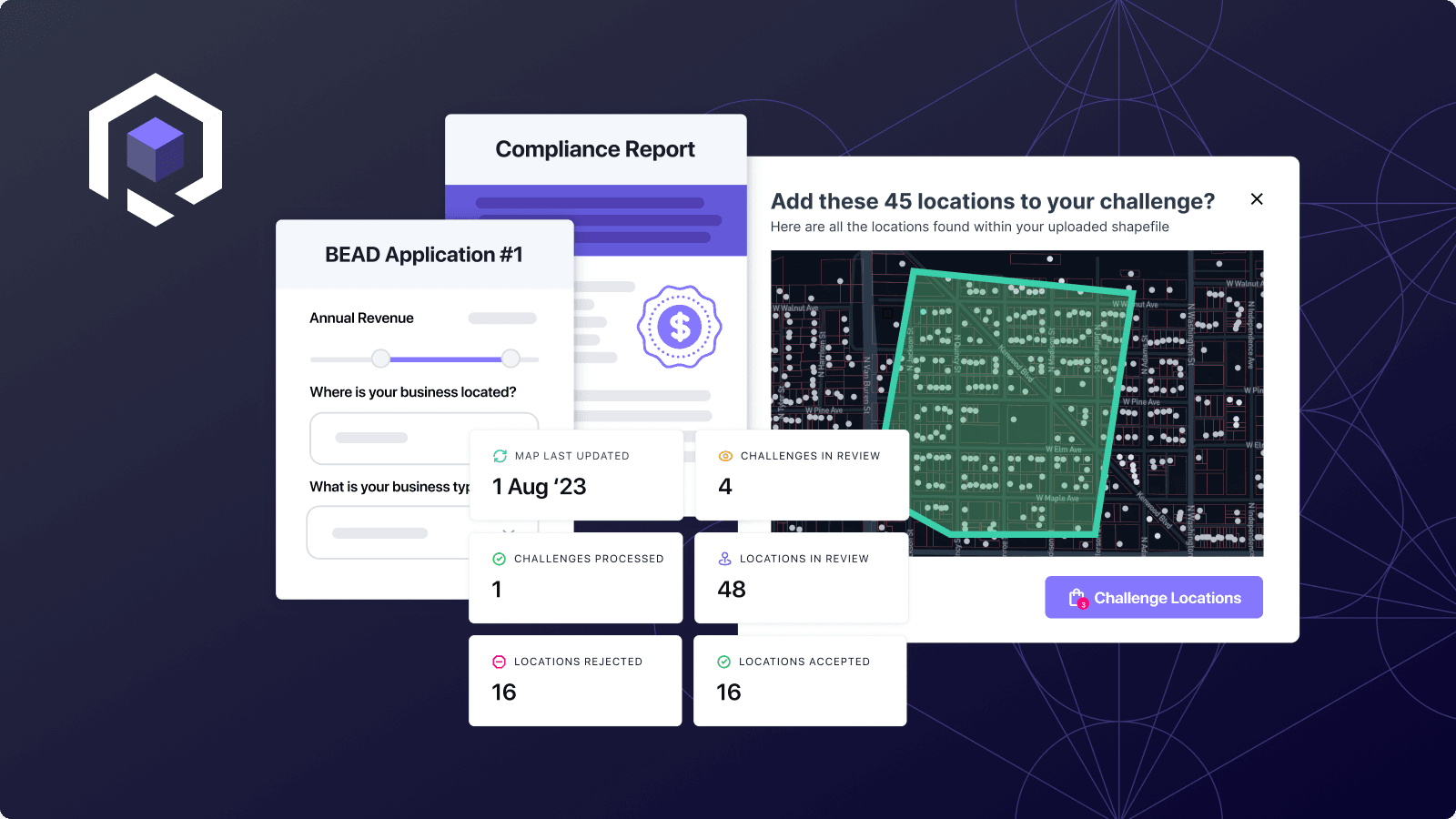
Key Principles for the Data-driven State Broadband Office
15 min read
Harness data to illuminate your office's path through the fog of BEAD!
State broadband directors are tasked with ensuring affordable, reliable access to broadband for millions of families. This unprecedented initiative, fueled by NTIA’s flagship BEAD program, everything about the U.S. last mile is about change at the hands of State Broadband Offices.
Successful state broadband offices are guided by data-driven decisions in setting goals and measuring outcomes with the health and prosperity of millions of Americans at stake. Offices built on these principles can surpass the fog of BEAD implementation, achieve their goals and outperform offices that settle for “business as usual” outcomes. This ties directly to the director’s legacy.
Reaping the rewards of being data-driven
Data-driven state broadband offices should consistently run fair, objective, inclusive and auditable workflows with stakeholders.
Incorporating data-driven decisions into your office allows for clear, objective decisions to be made at the grueling pace of BEAD implementation. This also allows for offices to successfully face conflicting wants and needs, pressures from stakeholders on all sides and the giant congressionally-mandated hourglass on your desk.
This means avoiding the trap of working behind closed doors with special interests and answering behind-the-scenes to incumbent monopolies. Being data-driven requires integrity, willingness to seek and act upon evidence and the commitment to ensuring that all stakeholders have a seat at the table.
Why your office needs key principles in order to be data-driven
As in life, so in work: setting and sticking to key principles makes it possible to navigate a wide range of circumstances, especially during wide ranges of circumstances, even (especially) during high stakes, complex situations where tradeoffs are a matter of course.
Think of your principles working like the assembly of systems that make it possible for modern aircraft to fly safely in low- or no-visibility conditions. These work in the background to guide your craft to your intended destination, whether or not you have direct line of sight.
Principles will help you navigate the impending fog of war, even in the face of intense pressure. But what specific principles help you lead a data-driven office? The following list of principles are embedded and automatically enforced in Ready Grantor Platform. Whether you use that integrated full lifecycle system to run your program or not, you can copy them to build your own.
1: Encourage Broad Participation 🔑
Data-driven broadband offices must gather substantial information from a wide range of stakeholders throughout the program lifecycle.
Gathering, processing, and sharing data can be extraordinarily time-consuming for busy participants and meeting NTIA’s high bar for BEAD intimidates many would-be participants. Submitting information to your office in a compliant, timely way should not be a barrier to participating in your BEAD or other programs. The easier you make the process of obtaining necessary data from providers, the easier you make the business of complying with NTIA's strict guidelines for your office.
Leveraging data-driven workflows throughout the program lifecycle sets participants up for success. While it takes a little coordination up front on your part, doing so pays off if your office is running on a scalable platform. With purpose-built tools like Applicant Management System, your team can take in vast troves of data in a straightforward way that’s as easy as possible on participants.

If your platform is equipped with a provider relationship management system, you’ll efficiently be able to coordinate inputs, outputs, and communications with participating providers. As a result, more applicants applying to your program leads to a higher chance of fulfilling your vision. Funding even a small, selective subset of all applicants, the increased participation will result in increased competition resulting in higher quality bids, greater coverage, and a depth of providers you’ll be able to work with over time.
Why should you foster great relationships with all providers, even if you’ll ultimately only fund a small handful of those providers? If a chosen provider is unable to deliver, you’ll have alternates, giving depth to your program and enabling “Plan B” enforcement in your by way of your ongoing reporting and clawback mechanisms.
Your program should set and maintain a very high bar, but makes participation approachable for dozens or even hundreds of providers to participate, including very large providers.
With broader participation, you’ll also be able to work iteratively with applicants toward optimal allocations that maximize odds of successfully achieving your vision.
Additionally, you’ll gain access to a diverse range of projects, proposals, and teams, including your state’s local providers: mom & pop ISPs, Rural Electric Coops (RECs), telcos and those who’ve worked for decades to bring connectivity to your constituents. These teams generate economic vitality through their efforts and making it difficult could make applicants hesitant of the daunting tasks required to land BEAD funding.
Here’s some steps that state broadband offices can take for small, local & non-traditional providers to participate:
- Make it as easy as possible to apply, report, and comply
- Software built to facilitate your office’s required workflows, modeled to your vision
- Easy-to-use user experience & and simple user interfaces
- Clear instructions and guidance
- Accessibility: Section 508 compliance is an important starting point, combined with WCAG compliance it’s even better
- Reporting & compliance automation
- Templates for complex inputs, such as financial models – but they should plug directly into your application system with zero manual effort
- Easy, centralized communications
- Data-driven mailers, secondary addresses, SMS reporting options for constituents without reliable broadband or web interfaces
2: Enable Deep Partnerships 🔑
Whether directly or indirectly, offices must work with every provider seeking to provide service in their state.
Data-driven state broadband offices should view relationships with all providers who serve residents in-state as the opportunity to foster deep, long-term partnerships. Using collaborative geospatial software ensures those relationships are founded on trust.
Your grantor platform is the digital bridge between your office and the range of stakeholders with whom you must work. Your office and team benefit from supplying the portal through which all stakeholders participate in your data-driven processes, whether it's CAIs, tribes, local governments or public-private partnerships. This platform simplifies collaboration and communication with stakeholders and offers more time working toward goals together at a shared virtual table.

3: Precision Outperforms Politics 🔑
Modern society owes a great deal to precision. Everything from the microchips in the device you’re using to read this to the rockets that propel us to space – all are possible thanks to precision.
Set your target outcomes, define your tolerances, and work to enforce them. Remember: Excellence requires precision.
Precision equals clearly defined standards plus low tolerance. Precision requires a high bar in your evidentiary standards. Being precise requires the data-driven state broadband office to set specific parameters, goals, and tolerances in their rubrics.
Precision is an underrated tool in your toolkit in order to escape the gravity of politics. With specifications in hand, your office can conduct its processes in transparent, empirically-defensible ways.

In order to overcome politics with precision, the data-driven state broadband office establishes:
- Clearly defined, well-articulated standards. As you set your vision as codified in your 5-year plan, think beyond leaving your vision stranded in a lengthy document few will read. How will you assert your vision throughout your office’s programs using a platform built around your principles?
- Low tolerances for target values
- Processes for gracefully rejecting sub-standard inputs, or seeking iteration on sub-standard inputs.
Being data-driven lets your team rely on precision to guide stakeholders toward your vision:
- Find and error-correct undercounting
- Refute over reporting
- Process thousands of applications
- Automate checks against broadband audits
- And much more
To be exceptional at guiding public resources into broadband projects, your office must be data-driven in every process you undertake. Data is the best means to achieving precision.

Precision together with asking the right questions lets the data-driven state broadband office screen applications on merit, apples to apples, with insights that might otherwise go overlooked.
4: Iterate to Amazing! 🔑
Iterate to Amazing is based on the agile methodology of creating better and better software over time. Versions. Releases. App updates. These are some of the ways major software platforms iterate to amazing. Build your state office around iterative, collaborative processes with updatable inputs, feedback mechanisms, and responsive outputs and you can achieve value-compounding outcomes.
“Iterate to amazing” looks beyond the waterfall arrangement of BEAD dates to a process of continuous refinement while ensuring delivery of milestones. The data-driven broadband office views the program lifecycle as continuous.
Being positioned to incorporate better data over time allows the data-driven state broadband office to approach the journey to reliable, accessible broadband from the lens of error handling.
Build Measure Learn and OODA Loop are classic examples of iterate to amazing in action
Efficient iteration is a function of cost structure. If your process involves loads of manual effort, you’re less likely to get the reps you need in order to find the best possible arrangement of resources.
Consider the challenge process. NTIA devised a brilliant set of mechanisms to help your office navigate. By default, the process is extremely intensive – participation and evaluation are intensive exercises if done manually.
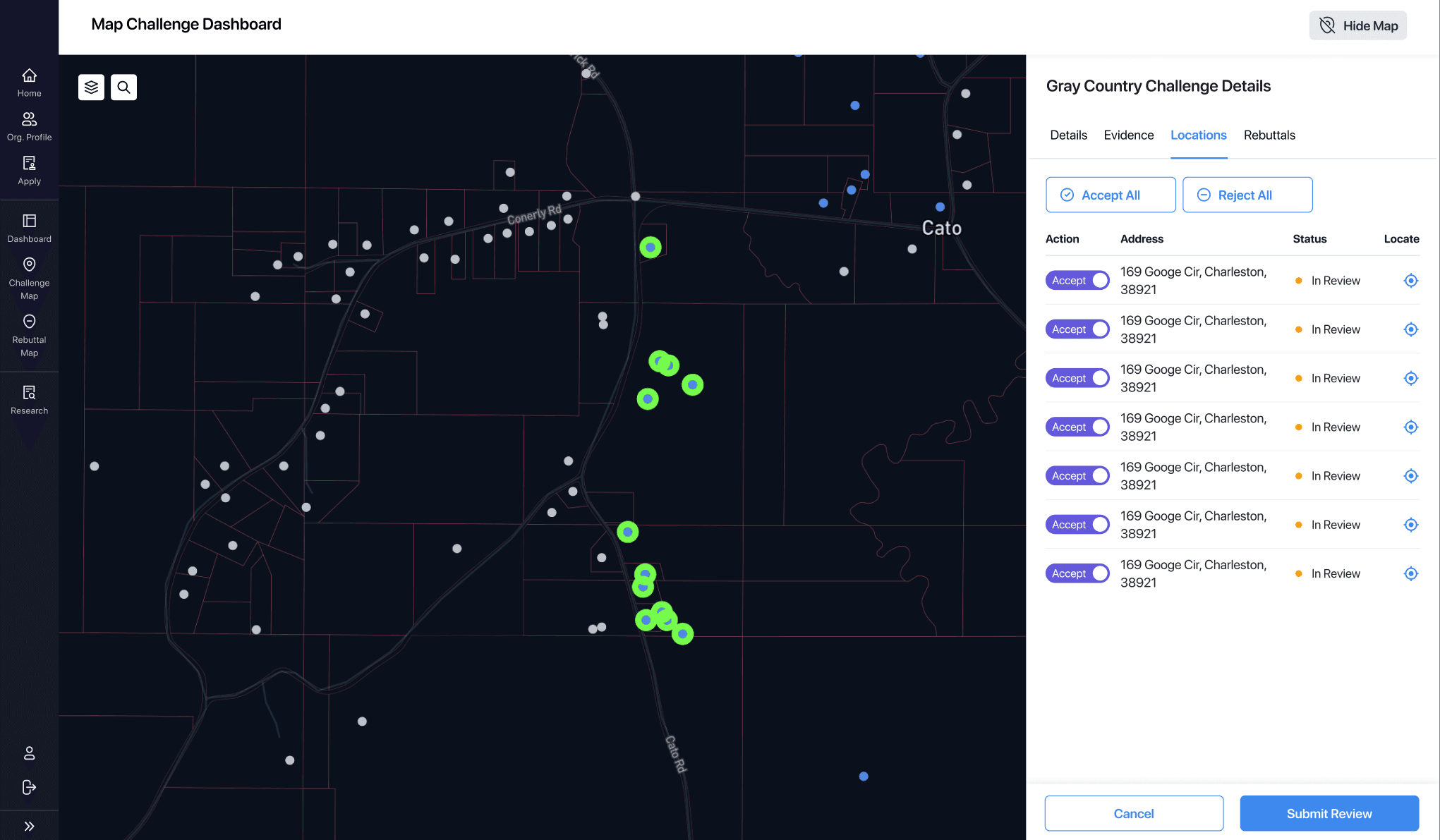
What if there weren’t 3 challenge process Challenge Process is ongoing? What if there were 33 instead of 3? With purpose-built tools like Challenge Process Coordinator your office can run NTIA’s Model Challenge Process, tuned to your vision for success, and do so with mere hours of team effort.
Consider the marginal cost of each challenge process you run nearing zero, and that a small team can now accomplish in hours what would normally take large teams weeks. Why would you limit yourself to only three challenges?
The same principle applies to every function your office facilitates. The data-driven state broadband office leverages integrated, data-driven tools like Ready Grant Optimizer to run simulations and explore scenarios without wasting a lot of time and money.
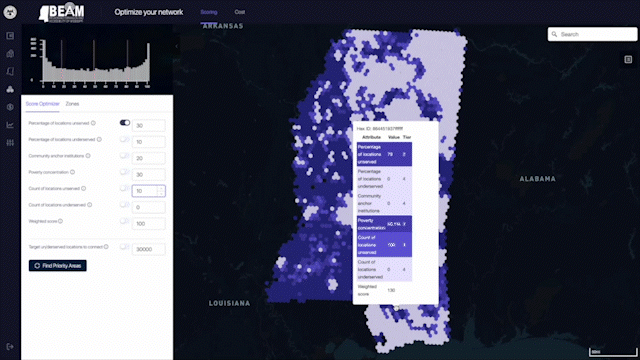
Parametric models running on your data sets allow your team to quickly, inexpensively explore scenarios at every step, from pre-award prioritization, to application modeling, to annual refinements as progress gets made.
5: Respect Tribal Data Sovereignty 🔑
Tribes are sovereign nations meaning that collecting their data without permission and direct cooperation from a Tribe is tantamount to spying on a foreign nation. Tribes often lack the tools needed to work with their data so it’s best to work with [Tribal Ready](https://tribalready.com) to make engaging Tribes as simple as possible. Ready Grantor Platform embeds Tribal Data Sovereignty throughout the program lifecycle. Whether you work with a Tribal specialist or not, the key to being a data-driven state broadband office is to incorporate Tribal Data Sovereignty into your processes.
6: Do the Math 🔑
The data-driven broadband office views self-reported inputs with healthy skepticism. This concept extends beyond provider coverage, encompassing every form of data supplied by participants. Doing the math relates to the timeless “trust, but verify” working principle: mind the source of inputs, find ways to verify those inputs, and do the math to make sure everything adds up.
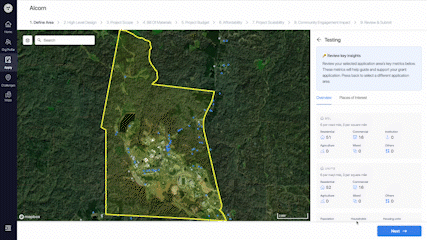
“Shifting the burden of proof” seems like a reasonable principle, but offices should take it a step further with independent verification as part of upfront diligence and ongoing monitoring.

7: Medium = Message 🔑
The simple idea coined by McLuhan six decades ago bears extraordinary weight in today’s digital world. While popular in the world of media, his essay mapped this concept to every technological extension (medium) employed by humans.
The Message is the Medium corresponds with [Conway’s Law]: any organization that designs a system will produce outputs whose structure is a copy of the organization's communication structure. By the same principle, the quality, substance and integrity of data you gather in your office’s workflows will be limited by the quality, substance and integrity of what you ask for, and how you ask for it.
Data-driven state broadband offices are fundamentally geospatial organizations with each step requiring deep synthesis between mapping systems and the other systems in your operation. Deep integration between mapping systems and other systems is required in order to achieve desired outcomes.

State broadband offices utilizing a shared, collaborative geospatial workflow platform will achieve greater results with less effort and fewer resources, resulting in greater broadband deployment and fewer headaches along the way. Offices relying on emails and basic web forms will receive fragments of already-processed information while those running on spreadsheets, pdfs, and standalone GIS files will have a piecemeal broadband implementation.
Collaborative, multi stakeholder geospatial workflows
The strongest broadband offices operate on an integrated platform designed to facilitate a wide range of collaborative, multi-stakeholder geospatial workflows tailored to their state’s vision of success. This can be hard for busy state directors to navigate, especially since most government technology procurement is built around procuring point solutions in a process not fast enough to help you deliver results in BEAD.

The office that relies on email and basic web forms will receive piecemeal already-processed information, requiring manual effort to extract, transform and load.
The office that incorporates a collaborative, multi-stakeholder geospatial data platform will receive high quality data streams, with the ability to combine into insights without needing hours of manual work per workflow.
Overcoming legacy procurement approaches
Procuring one-off, piecemeal off-the-shelf point solutions is a poor approach to running a data-driven broadband office. State offices that procure one-off point solutions over the course of the BEAD program risk creating years of painful manual collating, complicated stakeholder interactions , and ultimately, a fragmented, piecemeal outcome. State offices can use the model RFP for ideas and specific asks.
8: Anekāntavāda 🔑
Jainism’s timeless principle of “many sides to reality” can help your state broadband office be data-driven in the face of uncertainty.
“There are three sides to every story: your side, my side, and the truth. And no one is lying. Memories shared serve each differently.”
This principle means accommodating multiple points of view in decision-making processes. It requires the data-driven broadband office to seek, gather, and synthesize multiple data sources, triangulating disparate points using judgment.

9: CYA… AYSAT! 🔑
Your office will have a hard time conducting its core functions if it is sued by monopoly incumbents due to a data breach. To be data-driven, it’s important to make sure your entire tech stack is secured by the latest technology, and that your data collection, storage, and compliance retention practices meet stringent guidelines.
This principles is very simple, applying the golden rule to user safety:
Cover Your Ass… And Your Stakeholders Asses, Too.
Protect your office by protecting your stakeholders by ensuring automatically enforced grantor platform protections, such as requiring mutual non-disclosure among other practices:
Requiring mutual non-disclosure during your registration process is one example among many ways your grantor platform can help you stay safe by shielding your applicants data safe.
Providing a multi-user grantor platform environment for your team ensures continuity of your program, even if life has other plans for one of your team members during crucial processes.
Ensuring technologies you procure offer latest security practices – TLS, encryption at rest, etc.
Keeping time series records – your system should keep rigorous track of change over time. Doing so helps you track progress toward goals, spot anomalies, and stay compliant. Time series is a foundational concept in data-driven platforms but is hard to achieve in practice.
10: Automate as Much As Possible 🔑
Reporting and compliance burden is frequently cited as a top concern cited among prospective BEAD grant applicants. What can your office do to make ongoing reporting and compliance as simple as possible, while generating the most reliable, trustworthy data?
Automation is a great tool, but it has limits. Fiber splicing has yet to be automated but reporting and compliance obligations can be. Scripted collection, source-of-truth integration with grantee network monitoring systems, programmatic submissions, filings and even AI-assisted analysis can help your team spot anomalies that deserve a closer look.
Data-driven state broadband offices who make the most of their BEAD opportunity are the ones that automate with tools like Ready Grantor Platform Ongoing Monitoring, Reporting & Compliance Automation. Offices that don’t do this increase risk of failure.
Your post-award relationship lasts at least 10 years with your chosen providers.
11: Ask. Seek. Measure. 🔑
Gathering information needed in order to make sound, defensible choices is a fundamental requirement of the data-driven state broadband office. The strongest broadband offices tightly couple provider questionnaires together with time series data, independent research, and build up their provider profile in their grantor platform over the course of their programs, the outcomes of which they quantify and measure over time.
The data-driven broadband office asks in order to receive, seeks in order to find, and measures in order to manage.
You won’t know what you don’t ask.
If you waste your chance to get the insights you need in order to run your fair, inclusive, data-driven decision making process, you’re less likely to have what you need in order to ensure your program is fair, inclusive, and empirically defensible.
In venture investing, there is a concept of investing in lines, not dots: decision-making is higher resolution when trend analysis is possible.
Getting to know candidate operators before backing them is a superpower of the data-driven broadband office. Data-driven broadband offices ask intelligent, timely questions efficiently during the ramp up to BEAD applications. Broadband offices best positioned to deploy BEAD already have a quantitative understanding of the playing field before applications begin. Leverage your provider relationship management system in order to get to know your candidate applicant teams in advance of the fog of BEAD. Evaluate provider broadband audits and even do background research on providers to better understand who’s who.
You won’t know what you don’t seek.
When encountering discrepancies between self-reported service coverage and observational data, data-driven broadband offices go on proactive fact-finding with data-driven mailers. Send “Take the Test” QR codes cards to areas in your charge where provider reporting does not closely match your Broadband Audit. Where necessary, export research-worthy address regions from Challenge Process Coordinator submissions in order to trust, but verify.
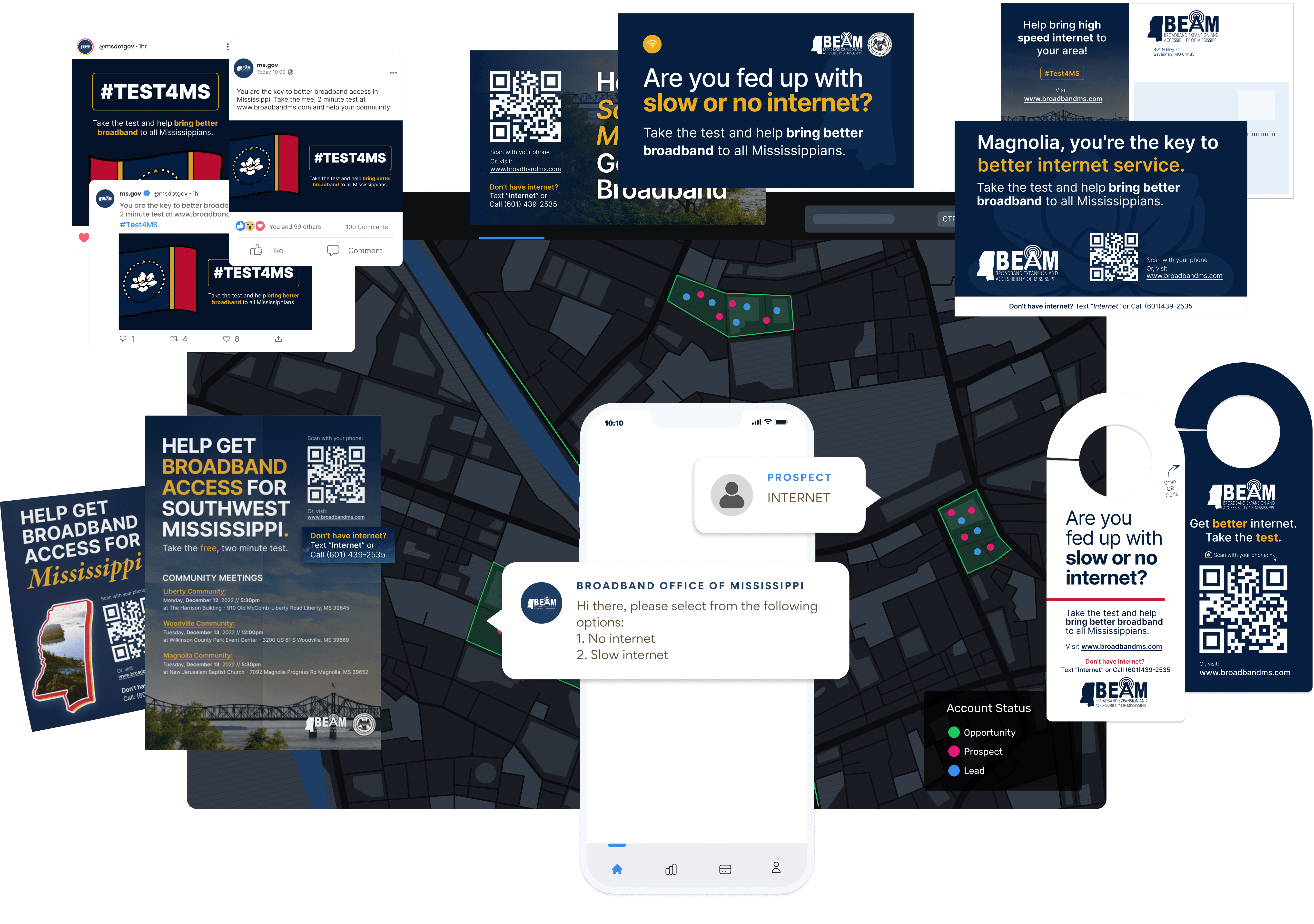
You won’t know what you don’t measure.
Data-driven broadband offices know they will make an enormous difference in the lives of many through their efforts. Return on Investment is one measure among many that data-driven state broadband offices set themselves up to track.
Mississippi’s State Broadband Office director Sally Doty envisions a future in which the BEAM team succeeds in distributing resources to capable broadband providers, working with them to ensure all Mississippians get access. Doing so, for Doty, means looking beyond the availability of broadband service into target outcomes to support her efforts to reduce child and mother mortality by ensuring high risk unserved areas have connectivity for life-changing advanced telehealth applications. Key Performance Indicator in Sally’s dashboard. While it will take years to move the needle, Sally and the BEAM team know their long term vision is worth measuring over the years ahead.
Each broadband office has one shot at making the most of BEAD. Data-driven broadband offices will outperform other offices. Key principles are required to be data-driven.
Whether you utilize Ready Grantor Platform to automatically set and enforce these principles for leading your office to data-driven outcomes, or you build your own platform from the ground up, or you decide to run your office through a patchwork of manual processes, you’ll benefit from key principles that aim to make your outcomes as data-driven as possible.

